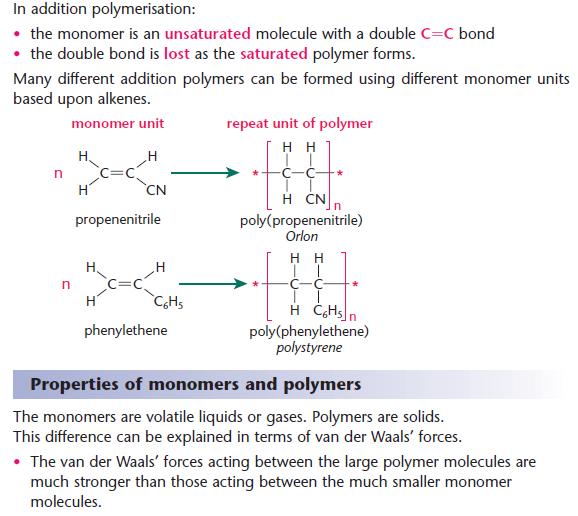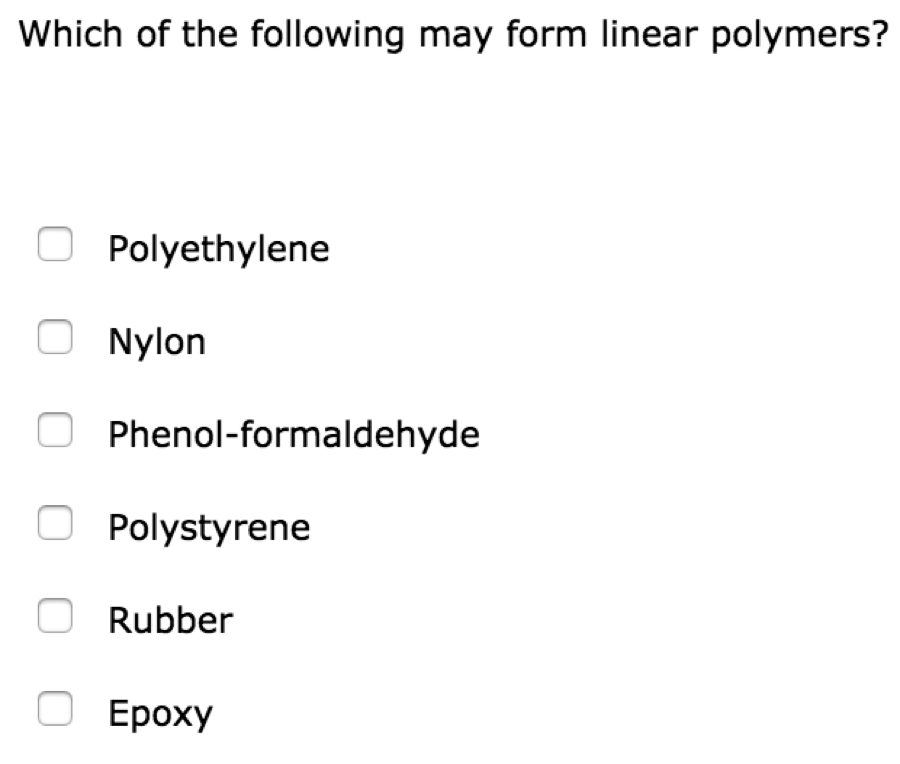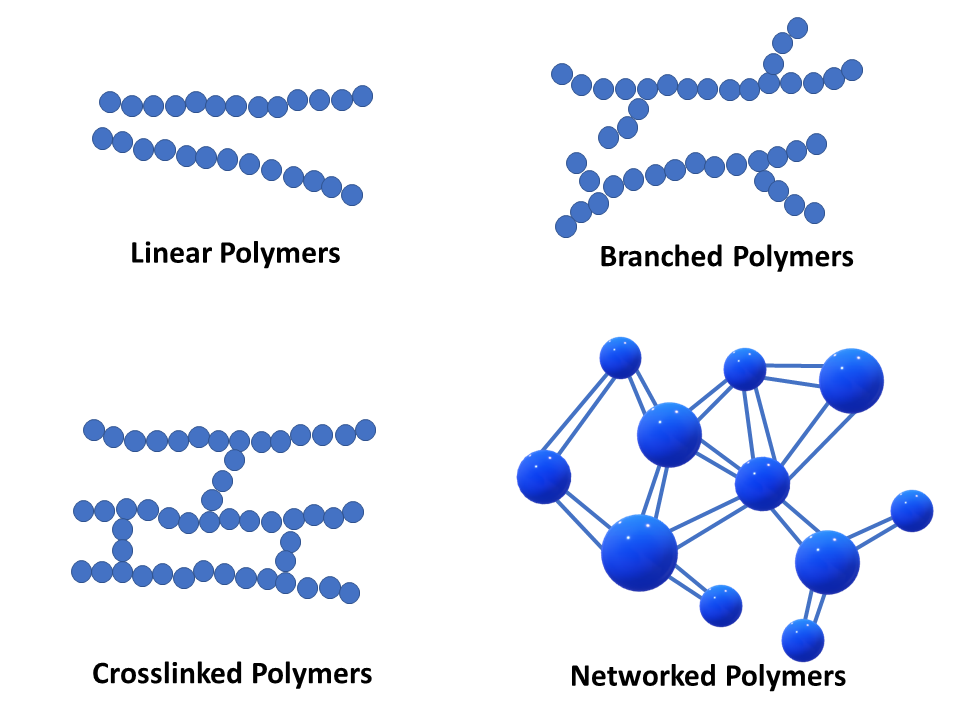Which Of The Following May Form Linear Polymers
Which Of The Following May Form Linear Polymers - Linear, branched, and network polymers.a polymer with a simple linear structure is formed. In some polymers shorter chains grow off the long chain at certain intervals, so that a branched structure is formed. In a solid plastic, a collection of these linear chains may be arranged in a completely random manner—looped, coiled, and. If the segments are connected through the carbon atoms, then a linear polymer chain results. Web a linear polymer characterized by a repetition of ester groups along the backbone chain is called a polyester. Which of the following form network polymers? How do the densities of crystalline and amorphous polymers of the same material that have identical molecular weights. Web which type (s) of bond (s) is (are) found between atoms within hydrocarbon molecules? These polymers have high melting points and are of higher density. Web six factors favor a polymer with a high percent crystallinity:
A linear polymer may be considered to be a collection of linear chainlike molecules, such as shown in figure 1.40. Web various polymer structures can be produced depending on the monomers and reaction conditions: Web which type (s) of bond (s) is (are) found between atoms within hydrocarbon molecules? Linear, branched, and network polymers.a polymer with a simple linear structure is formed. Web six factors favor a polymer with a high percent crystallinity: These polymers are composed of the main chain with more than one side chain and thus form branches. How do the densities of crystalline and amorphous polymers of the same material that have identical molecular weights. The monomers of polyvinyls have monomers as shown below. Note that for commercial synthesis the carboxylic acid components may actually be employed in the form of derivatives such as simple esters. Long chains of 10,000 or more monomers can be packed closely to form a.
These polymers have high melting points and are of higher density. In a solid plastic, a collection of these linear chains may be arranged in a completely random manner—looped, coiled, and. Which of the following form network polymers? Web which type (s) of bond (s) is (are) found between atoms within hydrocarbon molecules? To account for the physical differences between the different types of polymers, the nature of the aggregate macromolecular structure, or morphology, of each substance must be considered.because polymer molecules are so. A linear polymer may be considered to be a collection of linear chainlike molecules, such as shown in figure 1.40. A regular and symmetrical linear chain, a low degree of polymerization, strong intermolecular forces, small and regular pendant groups, a slow rate of cooling, and oriented molecules. Also, the polymerization reactions for nylon 6 and. How do the densities of crystalline and amorphous polymers of the same material that have identical molecular weights. Web a linear polymer characterized by a repetition of ester groups along the backbone chain is called a polyester.
(PDF) Latest Advances on the Synthesis of Linear ABCType Triblock
These polymers have high melting points and are of higher density. Linear, branched, and network polymers.a polymer with a simple linear structure is formed. If the segments are connected through the carbon atoms, then a linear polymer chain results. The monomers in these are linked together to form a long chain. Starches, an important source of food energy.
Polymers Chemistry ALevel Revision
A polymer may consist of linear macromolecules containing each only one unbranched chain. These polymers are composed of the main chain with more than one side chain and thus form branches. Which of the following may form linear polymers? In some polymers shorter chains grow off the long chain at certain intervals, so that a branched structure is formed. A.
Solved Which of the following may form linear polymers?
If the segments are connected through the carbon atoms, then a linear polymer chain results. A polymer may consist of linear macromolecules containing each only one unbranched chain. These polymers have high melting points and are of higher density. Polyvinyl chloride, polystyrene and polyethylene are examples of the polyvinyl family. A linear polymer may be considered to be a collection.
Polymer Chemistry 5 Types of Classification of Polymers
Web depending on the structure of the monomer and on the polymerization method employed, polymer chains may show different architectures. Web the following examples of condensation polymers are illustrative. A linear polymer may be considered to be a collection of linear chainlike molecules, such as shown in figure 1.40. To account for the physical differences between the different types of.
Stimuliresponsive polymer materials showing a variety of topological
To account for the physical differences between the different types of polymers, the nature of the aggregate macromolecular structure, or morphology, of each substance must be considered.because polymer molecules are so. In some polymers shorter chains grow off the long chain at certain intervals, so that a branched structure is formed. Which of the following form network polymers? Starches, an.
Difference Between Linear and Crosslinked Polymer Definition
How do the densities of crystalline and amorphous polymers of the same material that have identical molecular weights. Which of the following form network polymers? A linear polymer may be considered to be a collection of linear chainlike molecules, such as shown in figure 1.40. Web depending on the structure of the monomer and on the polymerization method employed, polymer.
Which of the following is a linear polymer ? YouTube
If the segments are connected through the carbon atoms, then a linear polymer chain results. To account for the physical differences between the different types of polymers, the nature of the aggregate macromolecular structure, or morphology, of each substance must be considered.because polymer molecules are so. Which of the following may form linear polymers? In some polymers shorter chains grow.
PPT Which of the following compounds may be polymers? PowerPoint
Polyvinyl chloride, polystyrene and polyethylene are examples of the polyvinyl family. In some polymers shorter chains grow off the long chain at certain intervals, so that a branched structure is formed. Note that for commercial synthesis the carboxylic acid components may actually be employed in the form of derivatives such as simple esters. A polymer may consist of linear macromolecules.
Linear, Branched and Cross Linked Polymers and Polymer Crystallinity
The monomers of polyvinyls have monomers as shown below. Polyvinyl chloride, polystyrene and polyethylene are examples of the polyvinyl family. Web a linear polymer characterized by a repetition of ester groups along the backbone chain is called a polyester. The monomers in these are linked together to form a long chain. A regular and symmetrical linear chain, a low degree.
DrakeOwFernandez
Polyvinyl chloride, polystyrene and polyethylene are examples of the polyvinyl family. Long chains of 10,000 or more monomers can be packed closely to form a. To account for the physical differences between the different types of polymers, the nature of the aggregate macromolecular structure, or morphology, of each substance must be considered.because polymer molecules are so. Cellulose and natural rubber.
Long Chains Of 10,000 Or More Monomers Can Be Packed Closely To Form A.
Those with high molecular weights (10,000 to 15,000 molecules) are employed in the. These polymers are composed of the main chain with more than one side chain and thus form branches. These polymers have high melting points and are of higher density. Note that for commercial synthesis the carboxylic acid components may actually be employed in the form of derivatives such as simple esters.
A Regular And Symmetrical Linear Chain, A Low Degree Of Polymerization, Strong Intermolecular Forces, Small And Regular Pendant Groups, A Slow Rate Of Cooling, And Oriented Molecules.
The monomers of polyvinyls have monomers as shown below. These polymers possess a single linear chain with zero branches. Web six factors favor a polymer with a high percent crystallinity: A linear polymer may be considered to be a collection of linear chainlike molecules, such as shown in figure 1.40.
The Monomers In These Are Linked Together To Form A Long Chain.
To account for the physical differences between the different types of polymers, the nature of the aggregate macromolecular structure, or morphology, of each substance must be considered.because polymer molecules are so. Web which type (s) of bond (s) is (are) found between atoms within hydrocarbon molecules? These polymers are similar in structure to a long straight chain which identical links connected to each other. Web depending on the structure of the monomer and on the polymerization method employed, polymer chains may show different architectures.
If The Segments Are Connected Through The Carbon Atoms, Then A Linear Polymer Chain Results.
Polyvinyl chloride, polystyrene and polyethylene are examples of the polyvinyl family. Web a linear polymer characterized by a repetition of ester groups along the backbone chain is called a polyester. In a solid plastic, a collection of these linear chains may be arranged in a completely random manner—looped, coiled, and. In some polymers shorter chains grow off the long chain at certain intervals, so that a branched structure is formed.









